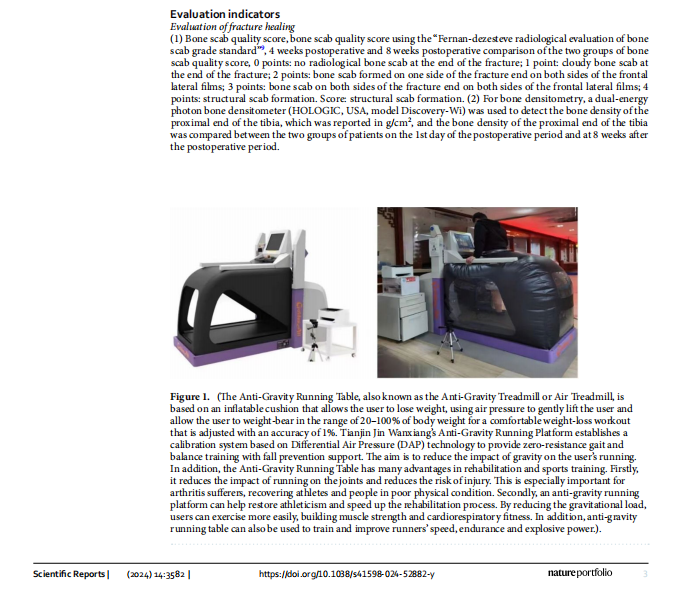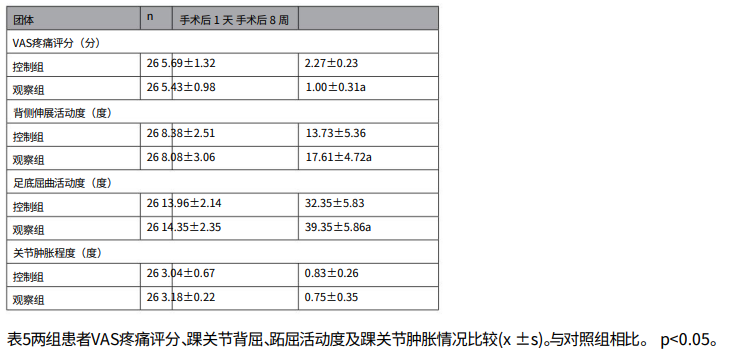About the author:Hunan Mechanical Electrical Polytechnic, Changsha, 410000, Hunan, China. The People’s Liberation Army Joint Logistic Support Force Sanya Rehabilitation and Recuperation Center, Sanya, 572000, Hainan, China. Department of Rehabilitation, Shenzhen Pingle Orthopedic Hospital and Shenzhen Pingshan Traditional Chinese Medicine Hospital, Shenzhen, 518000, Guangdong, China. 4Qiongzhong People’s Hospital of Li and Miao Autonomous County, Qiongzhong County, 572923, Hainan, China. Contributed equally.
Author:JiaWei Chen, TianYu Wu , Shuigen Liu , Ying Guo
The article has been published in the journal SCIENTIFIC REPORTS (JCR Division II, Chinese Academy of Sciences Q1 impact factor 4.996)
Key words: Standing bed training,Anti-gravity treadmill training,Ankle fractures,Functional recovery,Bone density,AOFAS score,Rehabilitation treatment
Purpose:Rehabilitation effect of standing bed combined with early anti-gravity running table training on ankle fracture
Methods: 52 patients with PER III or IV ankle fractures admitted to Shenzhen Pingle Orthopedics and Traumatology Hospital from September 2021 to January 2023 were selected for observation and divided into 26 cases in each group according to the method. Divide into control group and observation group according to random number table. Patients in the control group started routine rehabilitation treatment on the first day after surgery. They raised the affected limb and performed ankle pump training 0-2 weeks after surgery; they performed joint range of motion training, strength training and soft tissue release 3-6 weeks after surgery; Increase weight training at 6-8 weeks. On the basis of the treatment plan of the control group, the observation group added standing bed training on the 7th day after surgery and anti-gravity treadmill training on the 28th day after surgery. Compare the bone density, ankle joint mobility, American Orthopedic Foot and Ankle Society (AOFAS) ankle hindfoot score, pain, ankle joint mobility and swelling evaluation between the two groups before and after 8 weeks of treatment, and compare the callus quality scores of the two groups after 4 weeks of treatment.
Results:The use of bed rest and early antigravity treadmill training in postoperative patients with PER III or IV ankle fractures can reduce pain and improve ankle function.
Article cited in:Chen J, Wu T, Liu S, Guo Y. Rehabilitation effect of standing bed combined with early anti-gravity running table training on ankle fracture. Sci Rep. 2024 Feb 13;14(1):3582. doi: 10.1038/s41598-024-52882-y. PMID: 38351120; PMCID: PMC10864343.
Article link:Rehabilitation effect of standing bed combined with early anti-gravity running table training on ankle fracture
Ankle joint: The ankle joint is located at the lower end of the three major joints of the lower limbs. It needs to bear all the weight of the whole body and maintain the stability of the lower limbs, while also having flexible running and jumping functions. The bony structure of the ankle joint is composed of the distal ends of the tibia, fibula and Composed of the talus.
PER type fracture: It is a pronation-external rotation fracture. It is an ankle fracture that occurs when the foot is in a pronation position at the time of injury and the talus is subject to external rotation stress.
-
Clinically, surgery is the main method to treat PER ankle fractures. However, due to long-term immobilization of the injured limb after surgery, joint adhesion and joint effusion may occur, affecting joint function; pain, swelling, and pain may still exist in the late postoperative period. Problems such as functional impairment may even lead to traumatic arthritis, affecting the functional activities of the ankle joint.


Control group: (1) 0 to 2 weeks after surgery, patients with postoperative knee injuries were educated, the distal end of the affected limb was raised as high as possible, and patients were instructed to perform ankle pump training, once a day, and apply ice for 15 minutes immediately after the training. Minutes, the affected limb is encouraged to perform inward retraction, abduction, forward flexion, and back extension exercises, which mainly promotes the subsidence of ankle swelling and prevents blood clots from forming in the lower limbs and muscle atrophy; the treatment time is approximately 60 minutes; (2) Three to six weeks after surgery, this stage emphasizes ankle joint mobility training such as plantar flexion, dorsiflexion, varus and eversion, and strengthens strength exercises in all directions of the lower limbs and ankle joints. Activities, combined with joint loosening, muscle stretching and Guo Pingle’s kneading method, can promote the relaxation of soft tissues around the ankle joint and further improve the mobility of the ankle joint. The treatment time is about 80 minutes; (3) 6 to 8 weeks after surgery, continue the above treatment. For treatment, strengthen the strength training of the affected limb, continue to increase the active and passive range of motion exercises of the ankle joint, and strive to increase the range of motion of the joint to normal. Check the healing of the fold alignment based on Increase the weight of the load. The treatment duration is about 80-90 minutes, depending on the patient’s slight fatigue.
Observation group: Based on the treatment plan of the control group, standing bed training on the 7th day after surgery and anti-gravity treadmill training on the 28th day after surgery were added.


The results of this study show that after 8 weeks of continuous treatment, the affected ankle scab quality score, bone density, AOFAS ankle posterior score, pain, ankle dorsiflexion, and plantar flexion angle in the observation group were all improved.
Significant improvement compared with the control group. It was significantly better than the level before treatment and the control group (<. Only the degree of joint swelling was not significantly different from the control group.


The AOFAS Ankle Hind Score results of this study showed that the scores of the experimental group were significantly higher than those of the control group, indicating that early participation in anti-gravity treadmill training has a positive effect on the recovery of the ankle joint. Patients after ankle rupture surgery performed better when running on anti-gravity treadmills. Simulate the normal ground walking mode in advance under the Taiwan weight loss state. During training, the therapist sets the speed, slope, advance and retreat of the treadmill according to the patient’s specific conditions. The author analyzes that it can imitate the ground conditions in daily life, so that the patient can adapt to normal gait and train as early as possible to promote walking. Restoration of walking and ankle joint stability, support ability and other functions. Anti-gravity treadmill training not only provides patients with long-term, phased functional rehabilitation exercises, but also provides different anti-gravity training programs for different patients based on the safety of the exercises and the actual situation of the patient to ensure the patient’s recovery. Effect. The feasibility of a rehabilitation training program to prevent postoperative deformities and maintain joint stability and mobility.
In this study, compared with the control group, the observation group had lower VAS pain scores on the 1st day and 8th week after surgery, and greater postoperative ankle dorsiflexion and plantar flexion range of motion, indicating that anti-gravity treadmill training can reduce pain. and improve ankle mobility in patients with ankle joints. The reason is that early anti-gravity treadmill training makes up for the deficiencies in rehabilitation training. The weight-bearing intensity and time can be gradually increased according to the patient’s ankle joint activity, and the patient’s endurance and maximum range can be gradually increased. Training the movement of the ankle joint through gait data collection to improve the movement function of the ankle joint. Studies have shown that early rehabilitation training after ankle fracture surgery can accelerate blood circulation in the injured area, reduce inflammatory factors around the injury, thereby reducing pain, effectively relieving adhesion of surrounding tissues, and improving joint mobility.